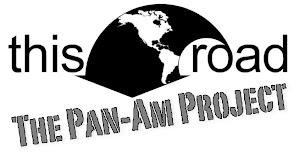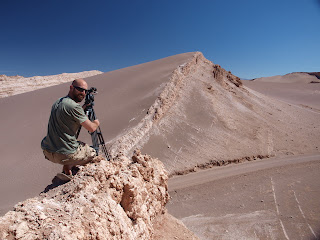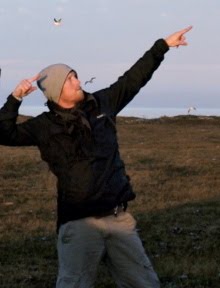Valle de Luna is so called because it looks like the surface of the moon. It is also hotter than the sun and at night affords the most spectacular stargazing on the planet.
En route to putting me on to a plane from La Paz to New York we had dropped in to San Pedro de Atacama to take in some of the spectacular scenery, and the final site on our hit list were the hot pools and geezers, a further 2000 meters above sea level and the highest in the world. At 2500 meters we barely noticed any effects of altitude but it was abundantly clear from the stark warnings from traveldoctor.co.uk that attempting to climb more than 300 meters a day from that altitude would invoke a brutal enviromental retribution. 3 hours later we had driven to the edge of the geezers with the plan of a nightime swim in the naturally heated pool while supping on Chilean vino and barbequed steak. Unfortunately, having driven Macbeth to an untimely death, the three Shakespearan witches had taken it upon themselves to prevent tourists from any such nightime chennanigans and we were reluctantly invited to spend the night in a dormitary at their outpost, 2k short of our destination. (Apparently the fact that these geezers shoot out boiling water is not condusive to nocturnal tourism - there is no light, we will die! Phil eloquently argued that our car had lights but unfortunately snakes, snails and indeed puppy dogs tails would not have moved them)

So, having thouroughly ignored the traveldoctor´s advice regarding Altitude Sickness, we commited the final atrocity of spending the night at 4300m. This was a bad choice. The next morning (to borrow another bit of army slang that is contaminating my vocabulary) we all felt utterly rats. The general consensus was to just get 5 minutes of the glorified kettles on film and then descend quicker than a cliff-dwelling lemming. Upsettingly when we got there it was an incredible sight to behold. Deserts (particular at that height) get a wee bit chilly at night, and the subsequent heat contrast spectacularly illuminates the huge jets of steam that each of the 20 or so geezers shoot into the air. This really should have been Tierra del Fuego (the land of fire), although considering our current physical state Phil was keener on The Valley of Death.
 |  |
When we had left the witches cavern earlier that morning, the first bus loads of tourists had started to arrive and so, keen to avoid the crowds, we drove over to the naturally heated pool to have a quick swim to ourselves. At this point it was still absolutley freezing and, feeling like death with the prospect of stripping down to swimming trunks ahead of us, morale was hitting an all time low. Luckily ThisRoad is made of sterner stuff, or more accurately we are all shameless exhibitionists in front of the camera. To be fair the swim was very pleasant if slightly unnerving. Rather than having a uniform temperature the gratifyingly steaming pool is a turbantly mix of cold currents to make you shiver and bursts of heated water that thankfully fall just short of scalding. Filming done we hurriedly dressed into every bit of warm kit we owned and pointed Barry down the mountain to the oxygen rich oases below. Admittedly not quite soon enough for my vaulting stomach, another lesson in altitude awareness.
 |  |
Our final destination in Chile before heading over to Bolivia was the northern coastal town of Arica. Its a surfers paradise and although we had no time to experience it, the follicly challenged of our group were reliable informed by our Point Break wannabe, uberman companion that the surf was excellent. The next morning we began the long ascent to the Chilean Bolivian border, a mere 5000 meters above sea level (where we had probably lost any of the acclimatisation from the Atacama the night before!) Barry, as utterly inescapely perfect-in-every-way as she is, is not the best climber, particularly when struggling to burn diesel in the oxygen depleted air, so we spent much of the journey crawling along at 20 miles an hour.
 |  |
 |  |
We arrived at the Bolivian border and were greeted by utter third world chaos, not entirely welcome at the best of times but even less so when breathable air had been reduced to 40 percent plus car fumes. We spent an hour trooping back and forth between different offices, trying to work out the order of stamps, photocopies, signatures, counter-signatures and tickets each utterly unhelpful "official" required. Finally everyone was satisfied and we drove to the exit gate, only to be told that our right hand car was not allowed into Bolivia. Fortunately just before our sense of humour failures began to register on the Richter scale Tom produced his International driving licence and blagged the guy into believing this meant our car could go anywhere we were allowed to drive in. It was quite obviously unashamed rubbish but the military-clad muppet waved us on, clearly content that he had dilligently defended his country´s borders.
 |  |
Now for the exciting part. After our previous altitude idiocy we had decided to camp in the lower plains (as indicated on our oh-so reliable Bolivian map) before driving up to La Paz, which stands around 4000 meters. Unfortunately from our border crossing at 500m to La Paz 300 kilometers away, we never dropped below 3800 meters. Which meant that we may as well stay in La Paz and hopefully not be too badly affected. We reached La Paz after nightfall which was by no means a good idea. Never in our lives have we experienced such incredibly chaotic driving conditions. It is a complete an utter free-for-all where cars and pedestrians, many carrying babies on their backs, compete for every conceivable inch of space to force their way forward. As we approached what we thought to be the centre, using our GPS as a guide, I congratulated Tom on the almost miraculous feet of not having hit anything. He smiled appreciatively. The driver of the car we crashed into was amiable enough, and having been directed by a traffic cop to a relatively safe place to pull over I agreed to pay him 8 US dollars for his broken tail light (we barely touched him but Barrys illegal Roo bars take no prisoners) However the dilligent traffic cop, obviously keen to ensure fairplay, decided that about 30 pounds worth of Bolivian Dollars would be a more appropriate remuneration. A cynical person may be inclined to summise that not all of that was going to the driver, we however held no such opinion. At least the cop gave us some proper directions and we finally learned a crucial fact about La Paz that is a huge benefit to navigating around it. It is absolutely massive and the city centre is 400 meters below the high point to which you enter (Actually named El Alto). As we finally cleared La Paz part 1 we could see sprawling benath us and absolutely breathtaking view of the second plateau below us, effectively a second city just as big as the first. And finally our maps made sense as up until then we had driven nearly 8kms through a city without a single road being on our map!

Having checked into our hotel we headed out for a quick bite to eat, and, at the advice of the hotel receptionist who definitely used the word commission while making our reservation, enjoyed our first ever llama dinner. The restaurant proprietor had warmly greeted us and, though he had to shoot off before our meal was over, promised us a free "snake schnapps" and unlimited access to the salad bar to welcome us to his restaurant. And on top of that I have to say that Llama is actually really good and definitely one of the better meals weve had on our travels. As promised the waiter brought over our free shot at the end of the meal, the bottle he carried covered by a cloth, no doubt to preserve the liquors intensity. Now, even if you havent worked behind a bar I am sure you are all aware that various drinks are not necessarilly named for their contents. Sex on the beach for instance is happily not a mix of sand and, well you get the drift. So when the proprietor had said snake schnapps earlier I hadnt completely prepared myself for the waiter to wip off the bottle covering cloth to reveal a goddamn boa constrictor staring 4 inches from my inadvisable inquisitive face. The other two may have delighted in the fact that I recoiled quicker than a cocktail bound cobra but seriously, who expects to be served that? The baby boa was sat, immersed in schnapps with its head bobbing from side to side as the waiter poured out 3 shots. Cheers.




















































